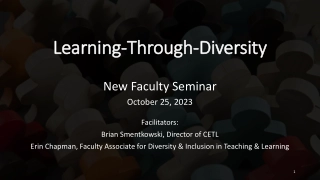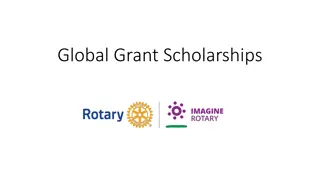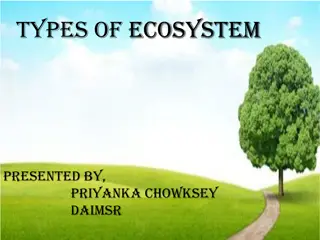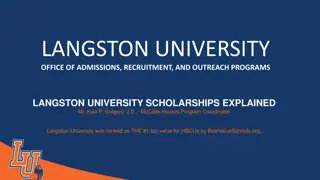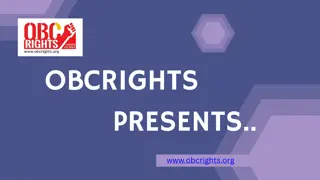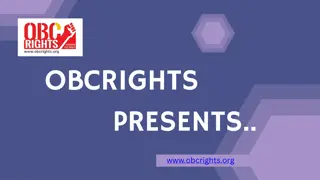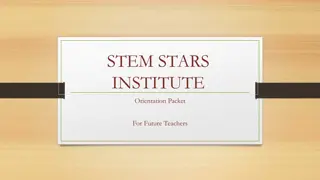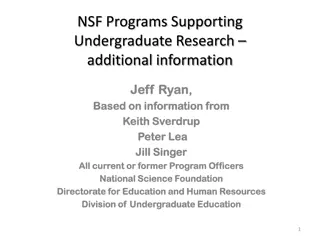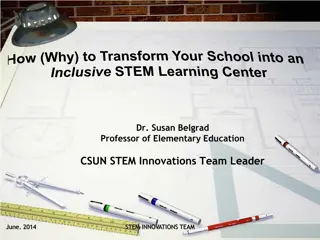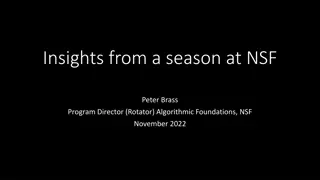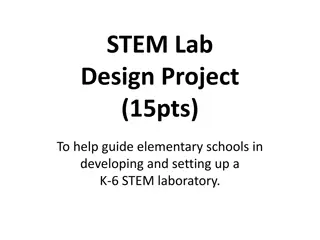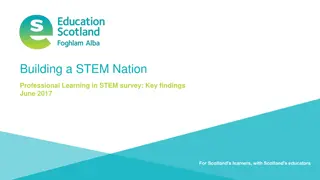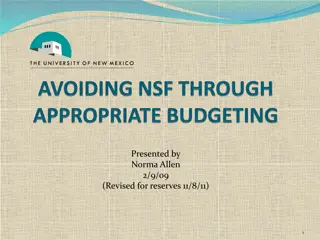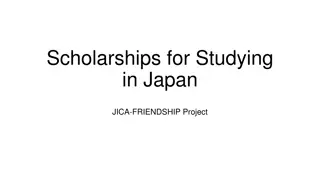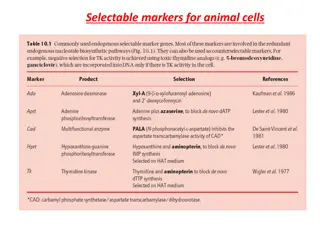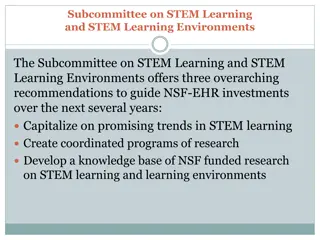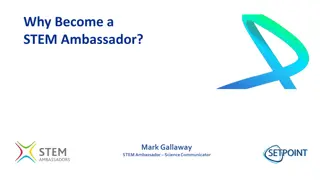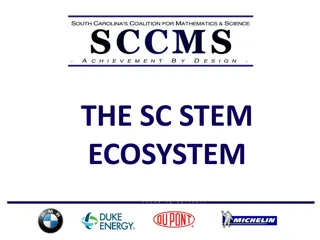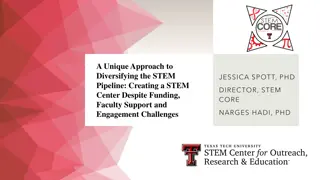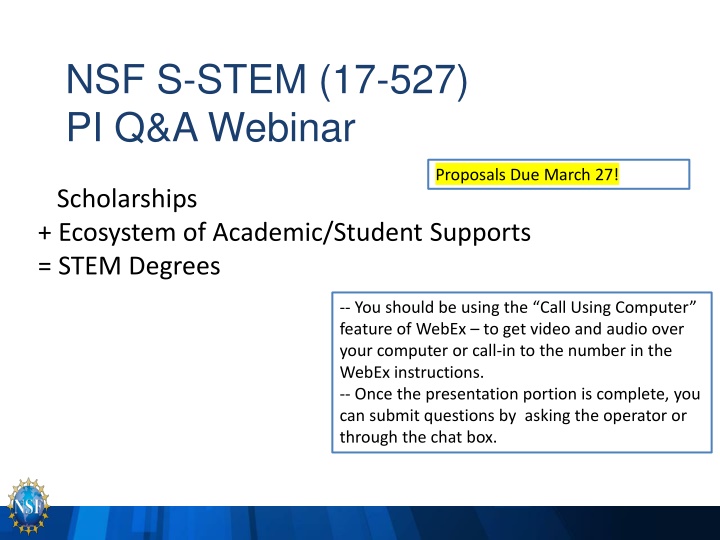
NSF S-STEM Scholarships & Academic Support Ecosystem
Proposals for NSF S-STEM (17-527) scholarships aim to support students in STEM disciplines through a robust ecosystem of academic and student supports. The program emphasizes workforce motivation, institutional planning, and STEM degree pathways. Prior NSF support and building on past experiences are key components for successful proposals.
Download Presentation

Please find below an Image/Link to download the presentation.
The content on the website is provided AS IS for your information and personal use only. It may not be sold, licensed, or shared on other websites without obtaining consent from the author. If you encounter any issues during the download, it is possible that the publisher has removed the file from their server.
You are allowed to download the files provided on this website for personal or commercial use, subject to the condition that they are used lawfully. All files are the property of their respective owners.
The content on the website is provided AS IS for your information and personal use only. It may not be sold, licensed, or shared on other websites without obtaining consent from the author.
E N D
Presentation Transcript
NSF S-STEM (17-527) PI Q&A Webinar Proposals Due March 27! Scholarships + Ecosystem of Academic/Student Supports = STEM Degrees -- You should be using the Call Using Computer feature of WebEx to get video and audio over your computer or call-in to the number in the WebEx instructions. -- Once the presentation portion is complete, you can submit questions by asking the operator or through the chat box.
Webinar Outline Presentation Section Introductions S-STEM Big Picture Ideas Project Team Institutional Planning Evaluation Knowledge Generation / Research Question & Answer Section
The Big Picture for S-STEM Proposals Supported Disciplines are listed in the solicitation Workforce Motivated locally, nationally, in the present and near future H1B visa fees Institutional Scans Strengths you can build upon Attrition points you can address prior/current S-STEM & STEP awards Describe the STEM degree pathway the path from a student receiving a scholarship to entering the workforce with degree in hand (or moving to another institution for a more advanced degree).
Supported Disciplines Be enrolled full time in a program leading to an associate, baccalaureate, or graduate degree in one of the following disciplines for each term for which a student receives a scholarship: biological sciences (except medicine and other clinical fields); physical sciences, including physics, chemistry, astronomy, and materials science; mathematical sciences; computer and information sciences; geosciences; engineering; or technology areas associated with the preceding fields (e.g., biotechnology, chemical technology, engineering technology, information technology); Others (not necessarily excluded) -- make the case using STEM content of the core of studies Likely destination in the workforce (STEM jobs)
Prior NSF Support PAPPG Anything with a PI or Co-PI -- as a PI or Co-PI -- and a start date in the last 5 years S-STEM Solicitation If there have been any prior S-STEM or STEP (STEM Talent Expansion Program) awards at the institution, the proposed project should build on the experience from the prior or ongoing project. Proposals should include quantitative and qualitative outcomes of any current or former project(s) and how the experience has informed plans for the current project. This is especially true when the same or related disciplines are involved, even if there is no overlap in personnel.
The Project Team The Project PI is a STEM faculty member (who teaches students the project supports) The Project Team contains an administrator Co-PI who can help get things done an educational researcher Co-PI who will lead the knowledge- generation effort You are allowed a total of 5 (1 PI and 4 Co-PIs) The Project has an independent evaluator who is NOT a Co-PI has a biosketch included receives about 5%-10% of budget Have a management plan clearly describing everyone s responsibilities. No wages == FER document
Institutional Planning 1 Estimate the number of students who will be supported on scholarship based upon the average unmet financial need of current students (and acknowledges the range of unmet need). My plan is consistent with the $10,000/year limit the student 4 year limit > 60% on scholarships Want to reduce a student s need to work! Scholarship applicants will be selected based upon a clearly specified holistic criterion for high-ability (or high potential) with rationale a clearly specified criterion for low-income with rationale These are the only criteria selection should be based on some formula involving the criteria or an equal chance Promoting diversity
Institutional Planning 2 Specify a cohesive set of student support structures consistent with the disciplines covered, my institutional scan, and project goals. S-STEM has considerable flexibility (<40% of the budget) Intellectual Cohesiveness Have established relationships with institutional personnel in financial aid, admissions/recruiting, student services, advising Describe required elements student cohorts STEM faculty mentors
Evaluation Involve your evaluator in the writing of the proposal so that appropriate metrics for my project can be specified. Evaluation should contain both formative and summative components for project improvement and accountability. Avoid conflating research and project evaluation. Make sure goals, inputs, activities, outputs, and outcomes are aligned.
Knowledge Generation Specify research questions to guide the knowledge- generation effort (likely involving the distinct interventions that the project is testing as part of the support structures). Demonstrate knowledge of the educational literature regarding my project s support structures, student population, and institutional context. Select research methods and analyses that will answer the research question. Make use of published validated instruments to gather information related to the research questions. Dissemination of the knowledge gained will involve publications, conference presentations, and a web site (like every other proposal) plus an innovative dissemination vehicle that distinguishes my project.
S-STEM Program NSF 17-527 Three Program Tracks Design and Development Multi-Institutional Consortia (Track 3) Institutional Capacity Building (Track 1) Design and Development Single Institution (Track 2) #Students, Budget, Scope, Complexity of Support Structures, Up to $650K Up to 5 yrs Up to $5M Up to 5 yrs Up to $1M Up to 5 yrs Complexity of Research Questions For institutions with limited experience in implementing effective curricular and co- curricular activities Potentially transformative support structures and research questions. Seeks to leverage S-STEM funds with institutional efforts and infrastructure to increase and understand impacts 11
NSF Review Criteria Intellectual Merit of S-STEM Proposals Is the need or problem identified (to which the S-STEM project is a solution) clearly described? (Note: This should be more than financial need of students - all proposals submitted are due to financial need.) Is there relevant data of student retention and graduation rates? Do the PIs and senior personnel have the knowledge, experience and expertise to effective lead the project? Is there a well-crafted plan to recruit students with demonstrated academic ability or potential and financial need to assure a sufficient pool from which to select the number of scholars proposed? Are the selection criteria indicative of seeking talented scholars? What is the quality of the academic program for scholars? How does the project assure quality in the support/resources for scholars? Are you convinced that the project will be well managed? 12
NSF Review Criteria Broader Impacts of S-STEM Proposals Is the number of students and faculty involved appropriate for the scale and scope of the project? Will the project offer career pathways for students? What will be the legacy within the department(s), the institution and beyond? Is there a plan? If there is a plan to diversify the STEM workforce does it clearly show how it will recruit and support the students into studying STEM disciplines? Is the evaluation plan going to provide the PIs with useful feedback and guidance to make mid-course corrections? Will the knowledge generated benefit the broader STEM education community? 13
Questions ? Please ask your questions by contacting the operator or writing in the WebEx chat box!

